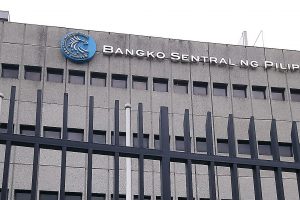




Monthly Economic Update: One for the road
 DOWNLOAD
DOWNLOAD

Inflation Update: Still low, still slow
 DOWNLOAD
DOWNLOAD

Philippines Trade Update: Exports momentum continues
 DOWNLOAD
DOWNLOAD


Term deposit yields end mixed on rate, inflation expectations

YIELDS on the term deposits of the Bangko Sentral ng Pilipinas (BSP) ended mixed on Wednesday as the market anticipates further rate hikes, but lower global oil prices and a stronger peso helped ease bets of large increases.
Bids for the term deposit facility (TDF) of the central bank amounted to PHP 377.197 billion, lower than the PHP 390-billion offer as well as the PHP 430.617 billion in tenders seen a week earlier for the same offer.
Broken down, tenders for the seven-day deposits amounted to PHP 190.262 billion, going below the PHP 220 billion auctioned off by the BSP and the PHP 237.656 billion in tenders a week earlier for a PHP 230-billion offer.
Accepted rates were from 6.27% to 6.45%, higher than the 6.2445% to 6.42% last week. This caused the average rate of the one-week term deposits to inch up by 2.31 basis points (bps) to 6.3553% from 6.3322% previously.
Meanwhile, the 14-day papers fetched tenders amounting to PHP 186.935 billion, higher than the PHP 170-billion offer as well as the PHP 192.961 billion in bids for the PHP 160-billion offering seen the previous week.
Lenders asked for yields ranging from 6.25% to 6.459%, narrower than the 6.2445% to 6.5% margin seen on Jan. 4. With this, the average rate of the two-week papers declined by 2 bps to 6.398% from 6.418% in the prior auction.
The central bank has not auctioned off 28-day term deposits for more than two years to give way to its weekly offering of securities with the same tenor.
The term deposits and the 28-day bills are used by the BSP to mop up excess liquidity in the financial system and to better guide market rates.
Term deposit yields were mixed due to hawkish signals from the BSP, Rizal Commercial Banking Corp. Chief Economist Michael L. Ricafort said in a Viber message.
BSP Governor Felipe M. Medalla on Tuesday said the central bank could consider a 25-bp or 50-bp rate increase at its meeting next month, citing the need to anchor inflation expectations.
He said the pressure to match the US Federal Reserve’s policy tightening was waning, and the need for a large adjustment is “no longer there.”
Still, the BSP chief noted that inflationary pressures are broadening and until that is addressed, monetary tightening will continue.
The Monetary Board raised rates by a total of 350 bps last year to tame inflation and slow the peso’s decline. This brought the policy rate to a 14-year high of 5.5%.
Meanwhile, the US Federal Reserve delivered 425 bps of cumulative rate hikes in 2022, which brought its own policy rate to 4.25-4.5%.
Mr. Ricafort said lower global oil prices and a stronger peso could help ease inflation and reduce the need for central banks to tighten policy. — Keisha B. Ta-asan
This article originally appeared on bworldonline.com





 By BusinessWorld
By BusinessWorld